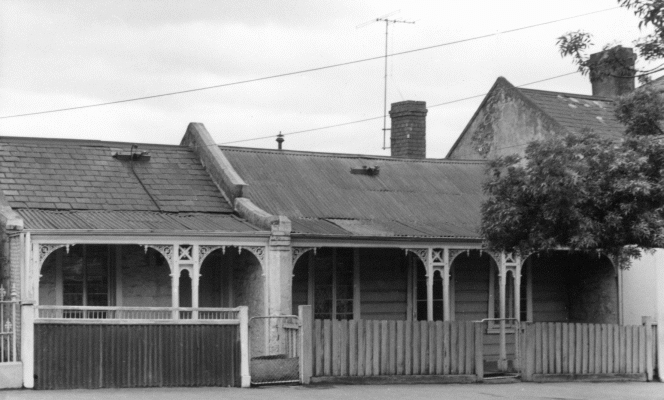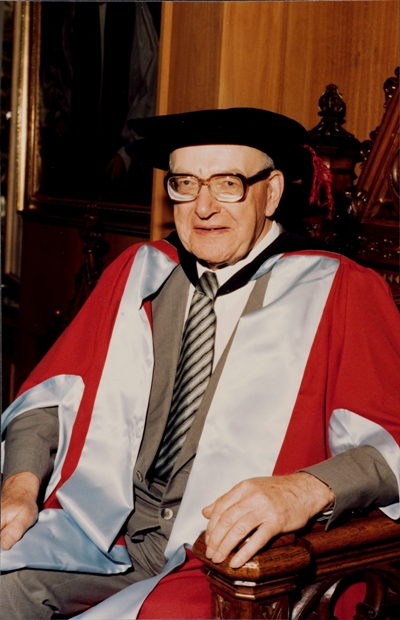University of Melbourne Social Survey
Download

Survey card no. 86: 64 Yarra Street, Collingwood, 1942
ink and pencil inscriptions on printed card
Wilfred Prest Collection, 1973.0002
University of Melbourne Archives

University of Melbourne Archives
From 1941 to 1943, Wilfred Prest (1907–1985), the newly appointed professor of economics in the Faculty of Commerce at the University of Melbourne, undertook a survey of living conditions throughout the suburbs of Melbourne. Prest’s team of female interviewers went door to door across approximately 6,500 Melbourne addresses, recording information about the residents’ ages, occupations and wages, noting details of living costs and nutrition, and observing the size and condition of the home.
Data was collected from approximately one in 30 households throughout Melbourne during the hiatus between national censuses (1933 to 1947). Prest published an analysis in his 1952 book Housing, income and saving in war-time: A local survey, by which time, Prest conceded, the data was mostly of ‘historical value’. Despite limitations, the survey prompted some important conclusions, in particular that family size – rather than unemployment – was one of the biggest contributors to poverty, and that rising incomes were creating housing shortages in Melbourne.
In 1973, the Wilfred Prest Collection was transferred to the University of Melbourne Archives, where it is preserved as an important social document of wartime Melbourne. The survey card shown here records data from a residence at 64 Yarra Street, Collingwood. On the reverse the interviewer has recorded additional observations.
Teaching ideas
The University of Melbourne’s curriculum is rich and varied, and changes from year to year. For more teaching ideas, contact a collection manager.
Social Differences and Inequalities
Discuss different factors contributing to social and economic equality and inequality in 19th- and 20th‑century Melbourne. How useful are national surveys like Prest’s, and how can the data best be used?
The Writing of Australian History
Examine the type of historical literature published in periods of war in Australia. Discuss how the writing compares to that from other points in Australia’s history, consider the method of research undertaken, and the tone of the language.
Sex, Gender and Culture: An Introduction
Discuss the gendered roles of those involved with Prest’s social survey: almost all the interviewers were women, while men directed the program and analysed the data. What was Prest’s intent in selecting women as interviewers? How did this fit into the cultural roles of men and women in Australia at this time?
Planning Theory and History
Study approaches to urban planning in Melbourne suburbs during the two World Wars. Discuss the developments that took place and consider whether they were effective.
Urban History
Investigate factors that may have influenced the character of Melbourne in the 1940s, considering the varying conditions described by participants in the survey. Compare and contrast development in different neighbourhoods in Melbourne’s suburbs.
Urban Environments
Use material from University of Melbourne Archives, for example Wilfred Prest’s survey, or the photographs of Jack O’Brien, to reimagine Melbourne’s suburban environments in the mid‑20th century.
Australian History
Investigate the experience of a Melbourne citizen before and during World War II. Discuss the major social changes brought by the war, and whether they remain visible today – either in the physical world or in primary source material held in University of Melbourne collections.
Intersecting objects
-

Jack O’Brien (Australian, 1909–1965)
17 and 19 Hanover Street, Fitzroy, Melbourne (built 1853–54), c. 1958
black and white photographic print
8.0 × 13.0 cm
Jack Lockyer (John) O’Brien Collection, 1965.0004.00054
University of Melbourne Archives -

Norman Wodetzki (Australian)
Professor Emeritus Wilfred Prest, on the occasion of his admittance to the degree of Doctor of Commerce honoris causa, 1983
colour photographic print
18.5 × 11.9 cm
Wilfred Prest Collection, 1986.0036.00162
University of Melbourne Archives
For further information, visit the website of University of Melbourne Archives.
References
Katrina Dean & Shirin Heinrich, ‘Wartime census: The University of Melbourne Social Survey’, UMA Bulletin, no. 31, July 2012, pp. 1–2.
Ellen Warne, Shurlee Swain, Patricia Grimshaw & John Lack, ‘Women in conversation: A wartime social survey in Melbourne, Australia, 1941–43’, Women’s History Review, vol. 12, no. 4, December 2003, pp. 527–46.